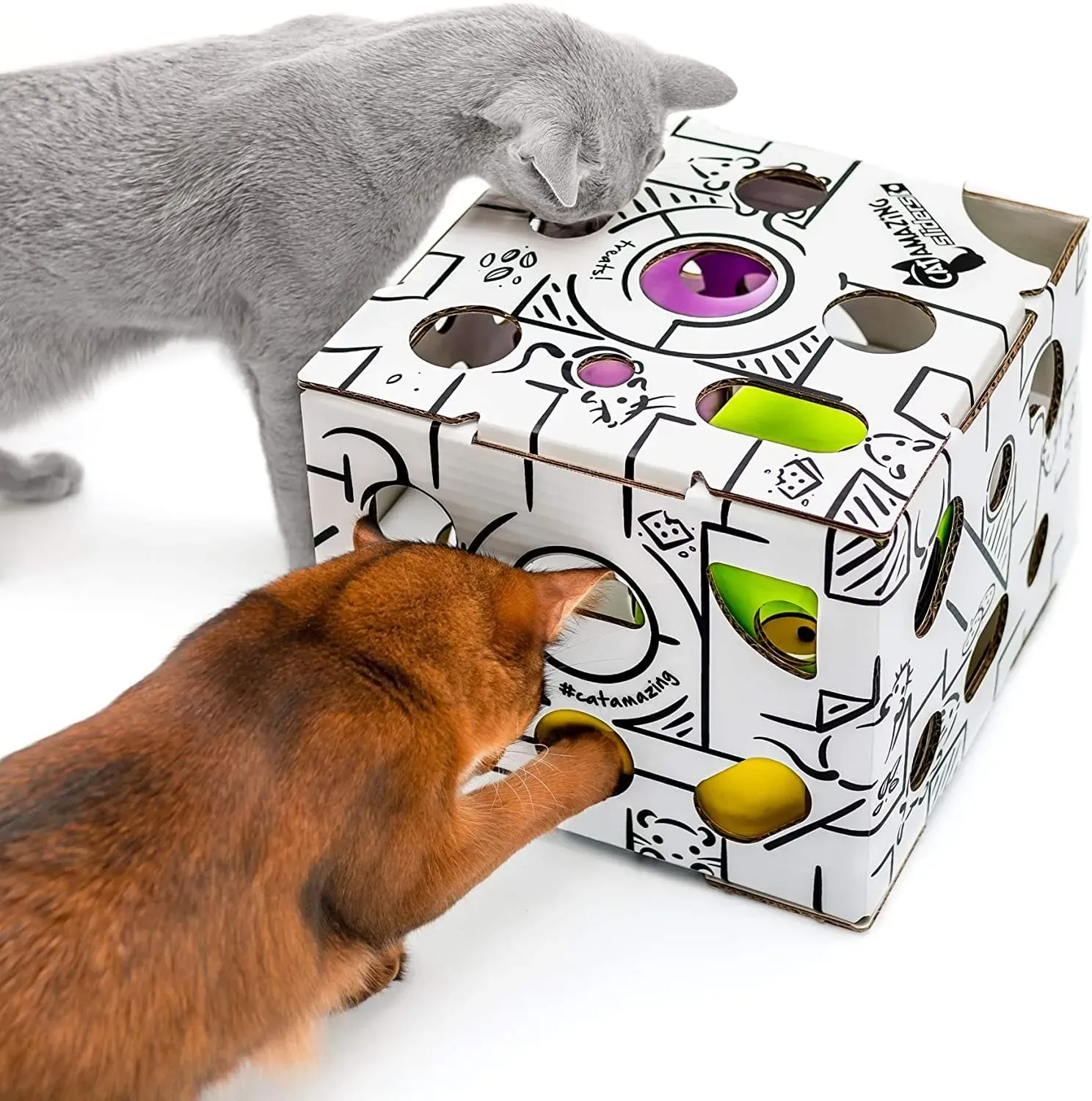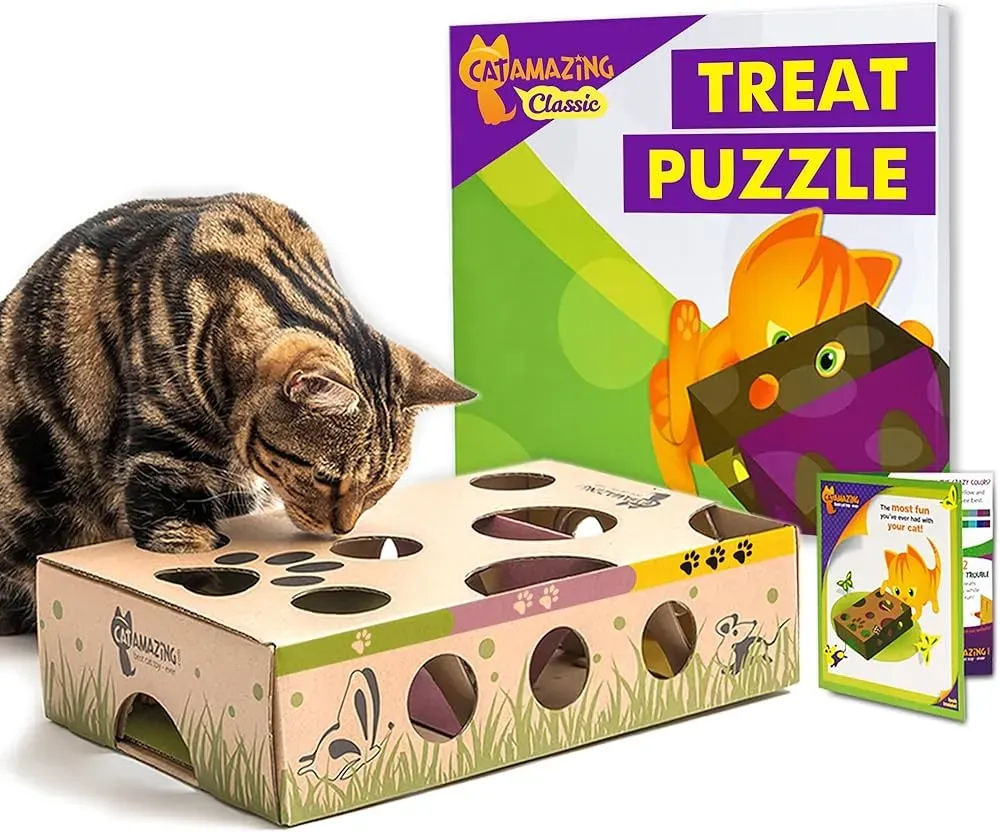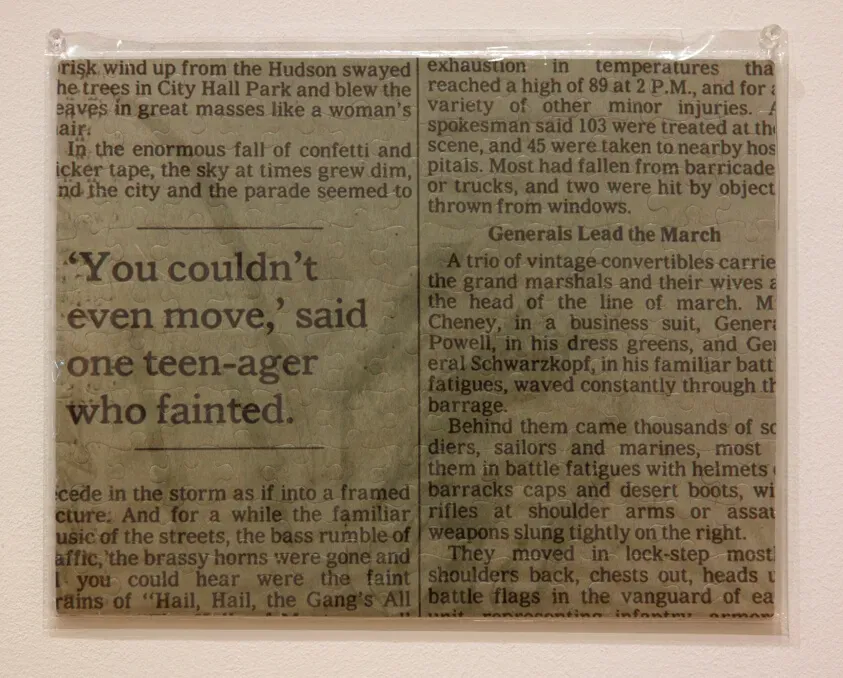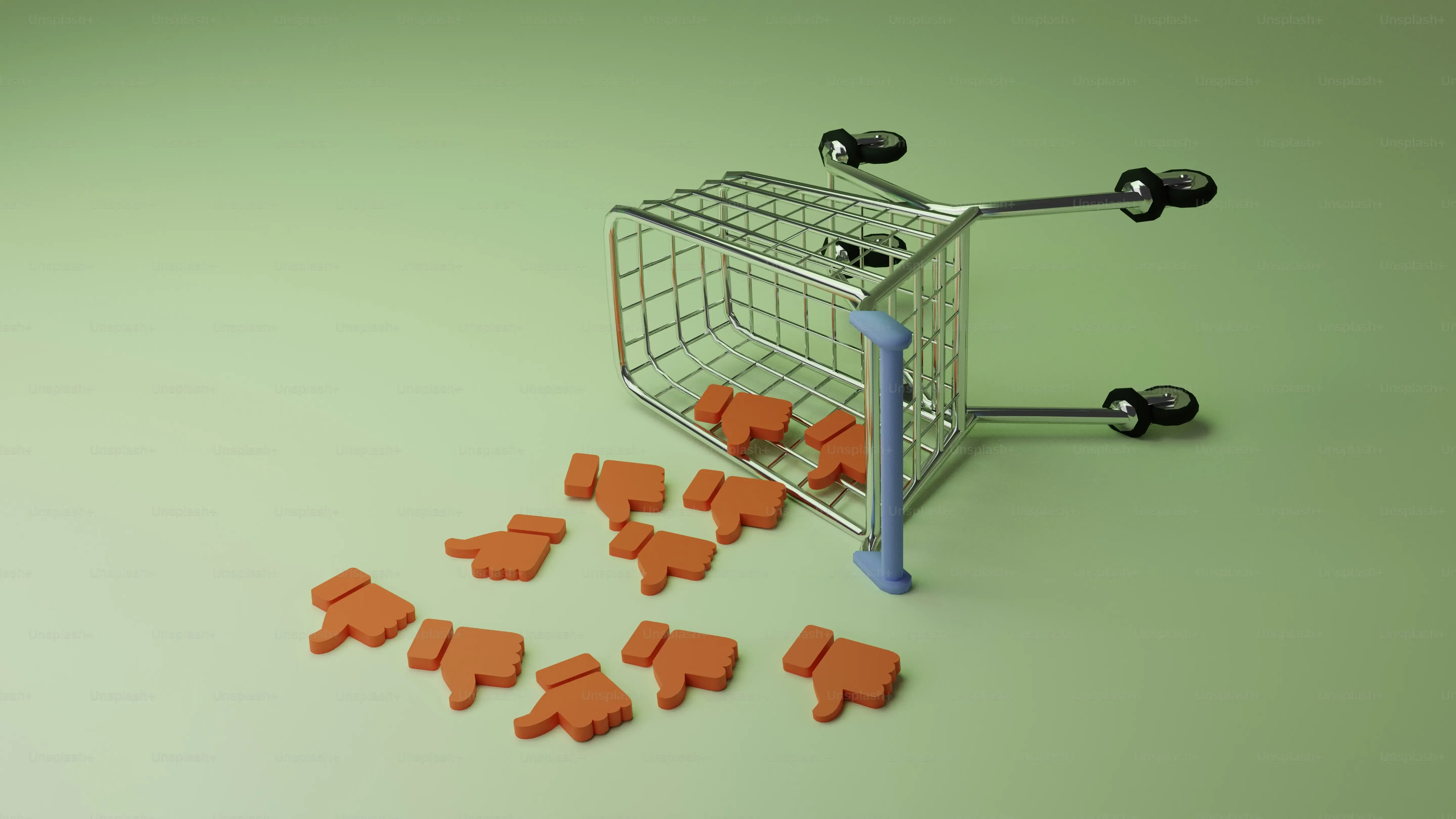Table of Contents
Ever watch your cat tear through the house at 3 AM like a furry tornado? Or maybe they inhale their food in ten seconds flat, only to look at you expectantly for more? Boredom and lack of mental stimulation are common culprits behind some less-than-ideal feline behaviors. Just like us, cats need challenges and engagement to stay happy and healthy. This is where the **best cat puzzle toys** come into play.
Why Your Cat Needs the Best Cat Puzzle Toys

Why Your Cat Needs the Best Cat Puzzle Toys
Tapping into Their Inner Hunter
let's be real. Your cat isn't just a fluffy couch ornament. They're tiny predators, hardwired to hunt, stalk, and capture. In your living room jungle, those instincts don't just vanish. Without an outlet, that pent-up energy and drive can manifest in ways you probably don't appreciate – like attacking your ankles or shredding the sofa. This is precisely why your cat needs the best cat puzzle toys.
These aren't just random plastic shapes; they are designed to mimic the challenge of finding food in the wild. Instead of kibble appearing magically in a bowl, your cat has to work for it. They must nudge, paw, batting, or manipulate the toy to release the goodies. This mental engagement is crucial. It prevents boredom, which is often the root cause of many feline behavioral issues. Think of it as giving their brain a much-needed workout.
Slowing Down Mealtime and Preventing Boredom
Many cats are what you might politely call "speed eaters." They inhale their food in seconds, then look around like they haven't eaten in days. This isn't just annoying; it can lead to digestive upset, vomiting, and even weight gain because they aren't recognizing they're full. The best cat puzzle toys force them to slow down. Instead of a free-for-all buffet, they get a few pieces at a time, requiring patience and effort.
Beyond just slowing eating, these toys provide a consistent source of enrichment. A bored cat is often a destructive cat. They might start knocking things off shelves, scratching where they shouldn't, or picking fights with housemates (human or animal). Introducing puzzle feeders gives them a job to do, a problem to solve. It redirects that potential mischief into a productive activity that satisfies their innate need for challenge and helps manage weight by controlling portion size and pace.
Consider these common signs your cat might benefit from a puzzle toy:
- Eating meals in less than a minute.
- Waking you up repeatedly for food.
- Displaying destructive behaviors like scratching furniture excessively.
- Seeming restless or agitated without clear cause.
- Carrying toys around while making hunting noises.
Types of Best Cat Puzzle Toys Available

Types of Best Cat Puzzle Toys Available
Slow Feeder Bowls and Mats
Alright, so you've got the speed eater problem. Before you jump into complex contraptions, sometimes the simplest tools make the biggest difference. Slow feeder bowls and mats are fantastic entry points into the world of the **best cat puzzle toys**. These aren't puzzles in the sense of hiding food, but rather creating obstacles within the bowl itself.
Think of them as speed bumps for kibble. They have ridges, peaks, or maze-like patterns that force your cat to navigate around them to get to the food. This physically slows down how fast they can gulp down their meal. Snuffle mats, on the other hand, are fabric mats with lots of hiding spots – fringes, pockets, folds – where you sprinkle kibble or treats. Your cat has to use their nose and paws to sniff out and extract the food, engaging their natural foraging behavior. They're great for wet food too, especially the LickiMats which are textured silicone mats you can spread wet food or lickable treats on, making them work for every bite.
Interactive Treat Dispensers
Now we're getting into toys that require a bit more brainpower and physical interaction. Interactive treat dispensers are designed to be batted, rolled, or nudged to release food or treats. These can range from simple balls with holes to more complex shapes.
The key here is that the cat has to *do* something specific to get the reward. A common type is a ball or cylinder with adjustable openings. You put the food inside, and as the cat bats it around, kibble falls out. Others might have multiple chambers or levels. My own cat, a particularly lazy ginger, initially just stared at one of these like I'd presented him with a quantum physics problem. It took some encouragement, rolling it gently myself and showing him food came out, before he got the hang of it. Once he did, though, it became his favorite way to eat.
Consider these features when looking at treat dispensers:
- Adjustable difficulty levels (smaller or larger openings).
- Size and weight suitable for your cat to move easily.
- Durability – can it withstand some serious batting?
- Ease of cleaning – important for hygiene.
- Non-toxic materials.
Complex Puzzle Boards and Mazes
If your cat is a certified genius (or just really food motivated), you might need to step up to complex puzzle boards and mazes. These often sit on the floor or a raised platform and feature various compartments, sliders, pegs, or drawers that the cat must manipulate in sequence or combination to access hidden treats.
Think of these as the advanced level of the best cat puzzle toys. Some involve pushing sliders, lifting cones, or rotating discs. The famous Nina Ottosson line has several excellent examples, like the Catstages Kitty Lickin' Layers or the Treat Maze. These require significant problem-solving skills and can keep a smart cat engaged for a good chunk of time. They're less about slowing down eating a whole meal and more about providing a challenging activity for a portion of their food or as a treat reward during playtime. Introducing these slowly, perhaps leaving some treats easily accessible at first, is key to preventing frustration.
How We Tested the Best Cat Puzzle Toys

How We Tested the Best Cat Puzzle Toys
Putting Toys to the Paws Test
so how do you even begin to figure out which are the **best cat puzzle toys** when shelves are overflowing with plastic and fabric contraptions? You don't just look at the packaging claims. You get actual cats involved. Our testing wasn't some sterile lab exercise. We rounded up a focus group of felines with varying levels of enthusiasm for work-to-eat challenges – from the hyper-motivated food hound to the skeptical observer who needed serious convincing.
We introduced each toy systematically. First, we showed the cats how it worked, sometimes even demonstrating with a treat ourselves (yes, we looked ridiculous). Then, we loaded it with their regular kibble or high-value treats and let them loose. We watched closely. Did they get it quickly? Did they get frustrated and walk away? Could they actually *get* the food out? Was it too easy, defeating the purpose? Was it too hard, leading to zero engagement?
Observing Engagement and Durability
The real test for the **best cat puzzle toys** isn't just if food comes out, but if a cat actually *enjoys* using it and keeps coming back. We tracked engagement levels over several days and weeks. Did the initial novelty wear off immediately, or did they integrate it into their daily routine? We noted how long they spent interacting with each toy during a feeding session or play session.
Beyond feline interest, durability was a major factor. Cats can be surprisingly rough. We checked if pieces came loose, if plastic cracked, or if fabric shredded after repeated use. We also considered how easy each toy was to clean – because let's face it, hygiene is important, and nobody wants to spend an hour scrubbing kibble gunk out of tiny crevices. A toy might be brilliant in concept, but if it's a nightmare to clean or falls apart after a week, it doesn't make the cut.
Here's a quick look at some key things we evaluated:
- Initial interest and ease of understanding
- Sustained engagement over time
- Effectiveness at slowing down eating or providing mental work
- Physical durability and quality of materials
- Ease of filling and cleaning
- Adaptability for different food types (kibble size, wet food)
Choosing the Best Cat Puzzle Toys for Your Cat
Matching the Toy to Your Feline's Flair
you've seen the options, from simple mats to multi-level contraptions. Now comes the slightly tricky part: figuring out which of the **best cat puzzle toys** is actually right for *your* cat. It's not a one-size-fits-all deal. A timid, easily frustrated cat will give you the feline equivalent of a eye-roll and walk away from a complex maze, while a Mensa-level feline genius will solve a slow feeder bowl in seconds and ask "Is that all you got?" You need to consider their personality, their age, their mobility, and their current skill level with work-to-eat activities. Start simple if they're new to this, maybe a snuffle mat or a basic treat ball, and gradually introduce more complex challenges as they get the hang of it. Pay attention to how they interact with their regular toys and food bowl – are they persistent? Easily bored? This gives you clues about what might work.
Consider these factors when selecting:
- Cat's Personality: Timid vs. Bold, Patient vs. Impatient
- Age and Mobility: Kittens and seniors may need easier puzzles
- Current Skill Level: Newbies vs. Experienced puzzle solvers
- Type of Food Used: Kibble size, wet food compatibility
- Ease of Cleaning: For your sanity and your cat's health
Expert Tips on Using Best Cat Puzzle Toys Safely

Expert Tips on Using Best Cat Puzzle Toys Safely
Starting Slow and Supervising Play
you've picked out what you think are the **best cat puzzle toys** for your furball. Don't just dump it in front of them full of food and expect magic. Introducing these toys requires a bit of finesse. Start with something easy, maybe putting just a few treats on a snuffle mat or leaving the openings on a treat ball wide open so food falls out easily. You're building confidence, not setting them up for failure. Always supervise the first few times they use a new puzzle toy. You need to make sure they understand how it works and aren't getting frustrated to the point of giving up or, worse, trying to chew pieces off. Some cats might try to dismantle the toy rather than solve it, which is a safety hazard. Stay close, offer encouragement, and if they seem stuck, give them a little nudge or show them how to get a treat out.
Think of it like teaching a kid to ride a bike. You don't just push them down a hill. You hold the back, run alongside, offer tips, and maybe use training wheels initially. Same principle applies here. You're their guide to this new, mentally stimulating world. Once they've mastered an easy level, you can gradually increase the difficulty by adjusting openings or moving to a more complex design. This keeps it challenging and prevents them from getting bored with the toy too quickly. Consistency is key; make it part of their regular feeding routine or a daily playtime activity.
The Real Payoff of Using Best Cat Puzzle Toys
So, there you have it. The quest for the **best cat puzzle toys** isn't about spoiling your cat with more plastic contraptions. It's about acknowledging they're sharp little predators whose brains need a workout just as much as their bodies. Skipping the puzzle toy means potentially dealing with a bored, overfed, or anxious animal. Putting in a little effort to find the right fit – whether it's a simple snuffle mat or a multi-level tower – can genuinely improve their quality of life and, frankly, yours. It might take a few tries to find their jam, but watching them figure out a new challenge is pretty satisfying. Consider it less of a toy purchase and more of a strategic intervention for feline well-being.